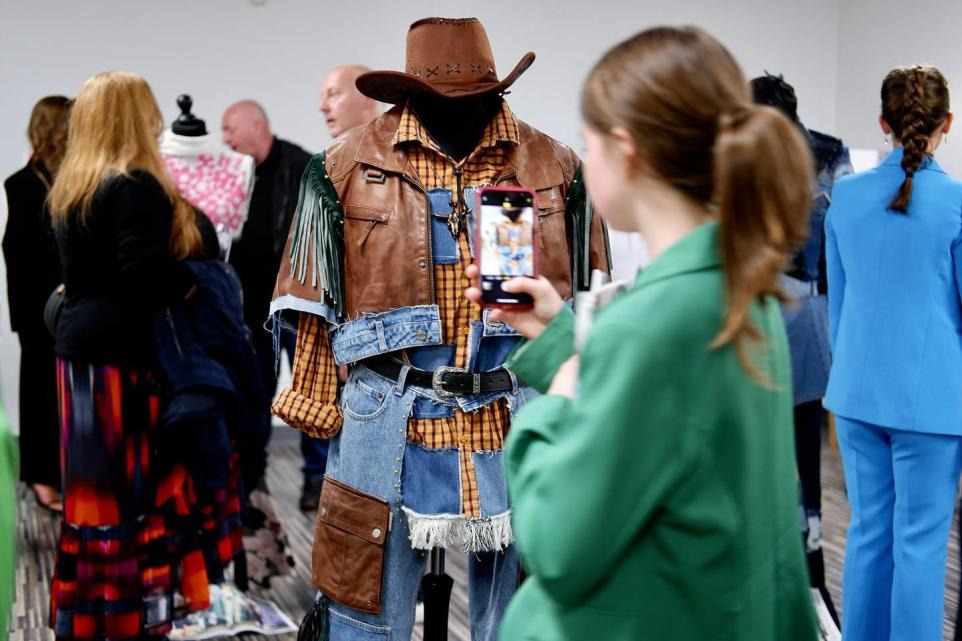British Textile Biennial back in Lancashire this October
12 September, 2023

The British Textile Biennial has announced a programme that focuses on the issue of sustainability in textile production, ahead of its exhibitions later this month.
The displays will be asking whether textile can ever be a regenerative enterprise, environmentally and socially.
The third edition of the biennial will trace the routes of fibres and fabrics across continents and centuries to and from the Lancashire textile industry, in a series of commissions and exhibitions throughout October.
The festival will run from September 29 to October 29, giving visitors a full month to view the numerous exhibitions that make up the event.
Artists from Benin to Bangladesh will present work that takes active steps to address the legacy of colonialism, while others look back on its pre-industrial history. From ‘slave cloth’, spun and woven by hand on the Pennine moors, to the bales of fast fashion that make their way from British high streets to the markets and toxic mountains of waste in West Africa, the exhibitions will explore centuries of the industry.
Built by its non-nonformist rural parishioners in 1765, Goodshaw Chapel, on the windswept Pennine moors above Crawshawbooth, was constructed in part from the proceeds of the trade of ‘slave cloth’.
This cloth was the coarse, hard-wearing hand spun and woven woollen and flax cloths which found ever-expanding markets of the plantations in the burgeoning colonies in the 1700s.
In a co-commission with English Heritage, artists Nick Jordan and Jacob Cartwright have worked with local artists and historians to create an installation in the charity’s building that tells its story through the centuries, accompanied by the legendary Larks of Dean.
Featured at Blackburn Museum will be the Penistone Cloth, a tiny fragment of cloth that recently came to light.
This type of fabric was used to clothe millions of enslaved people in the Caribbean and America for 200 years as they worked on sugar and cotton fields.
It will be accompanied at the museum by a timeline charting the complex global history that it represents.
The exhibition in The Cotton Exchange, Blackburn, charts the ongoing problematic relationship with cotton in a space which itself is bound up in that story.
Its opening in 1865 coincided with the Northern blockade of cotton from the plantations of the South in the American Civil War, in a stand against the enslavement of people transported from Africa.
For the first time, raw cotton will be presented on the floor of the Exchange, this time coming from three hectares of land in Benin, farmed by artist Thierry Oussou with local workers and agriculture students.
In this way, Oussou re-connects the dots of cotton manufacturing, pointing out the sequence of actions are often forgotten.
Nairobi's Nest Collective film demonstrates running in a structure built from the second-hand garment bales from the Northern hemisphere are destined for landfill in Ghana and dumped on communities in West Africa, stalling the local textile economy and contaminating the environment.
Nigerian artist Victoria Udondian’s wall hanging presides over the space made with refugee and immigrant textile workers in New York from discarded clothing often made in their countries of origin.
Meanwhile, out in Blackburn town centre, Jeremy Hutchison’s sculptures stalk the streets, created from the clothing bales destined for Africa, as a haunting reminder of what he calls our ‘zombie imperialism’.
Down the road from Goodshaw Chapel at Helmshore Mill, the Tenant of Culture presents Soft Acid that deconstructs the process of modern fabric production.
Throughout the 1700s, the government passed successive Acts of Parliament to regulate the cottage industry production in the north of England, to stem the production of cotton goods, muslin and calico, and their export from India and instead to transport raw cotton from the newly planted plantations of the American colonies to Liverpool and on to Lancashire.
Inventive entrepreneurs such as Arkwright from Preston and John Kay from Warrington were hurriedly trying to mechanise production, to bring the spinners and weavers out of cottages and barns and on to machines.
Higher Mill at Helmshore opened in 1789 and became expert in recycling cotton garments to re-spin the fibres.
The Whitaker Art Gallery in Rossendale was built in 1840 by George Hardman, who owned the mill it still overlooks.
In Christine Borland’s installation at Pendle Heritage Centre, four films are cast onto a Projection Cloth of fustian, a mix of linen warp and cotton weft, woven into the fabric of this medieval cruck barn.
Developed through the artist’s intimate engagement with the growing, spinning and weaving of plant fibres, the films reflect on the lives of women in transition from hand working, through mechanisation and industrialisation into the digital age.
The work touches on the enduring symbolism of the spinning wheel and distaff in the demonised image of women as witches, having particular resonance in Pendle where 10 women and one man, some of whom were handloom spinners, were the last to be hanged in England for the offence in 1612.
Material Memory is a display of textile items in the haunting space of Blackburn Cathedral’s crypt, loaned by members of the public, alongside the stories they tell.
Made precious by the care taken to keep them safe, the value placed on them by those who have prolonged their life and the deep connections they have created, sometimes across centuries and continents.
Challenging the throw away culture of our time, this exhibition demonstrates the deeply human desire to hold the simplest things dear.
Common Threads is a conversation through shared embroidery skills between women in Karachi and groups of women from the South Asian diaspora living in East Lancashire.
The British Textile Biennial will run from September 29 to October 29, and for full details of the exhibitions forming it visit the festival's website.
Useful Links:
Source: www.lancashiretelegraph.co.uk
